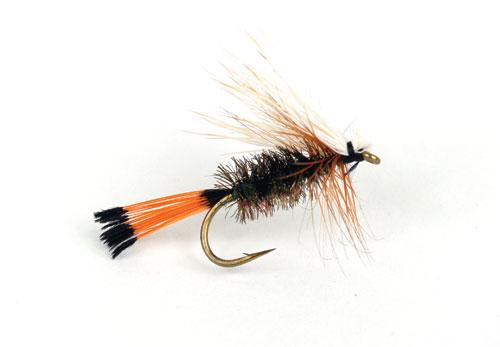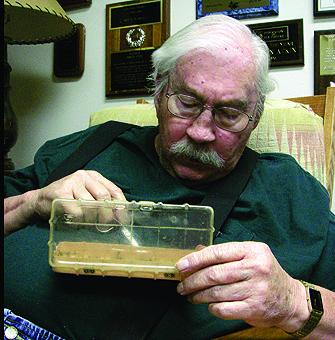Darwin Atkin, A Montana Fly Tying Legend
Montana is truly blessed to have a legendary fly tier and fly fisherman in its back yard—Darwin Atkin. He has spent the last 20 years living in Bozeman, living and breathing fly tying and fly-fishing. Originally from Southern California, he began his love affair with tying in 1959 during his senior year of college. His first motive to ty his own flies was to save money while we was putting himself through college. He thought that the prices of flies then were downright shocking and decided to buy a fly tying kit and learn how to make flies. What started out as a practical way to fill his fly boxes turned into a regular practice, which still deeply inspires him today, almost 50 years later.
He quickly developed a talent for the craft, becoming well known for tying flies to exacting proportions. He has been instrumental in turning the utilitarian craft of fly tying into the realm of art. While Darwin’s expertise as a tier is well known and highly respected, his skills in artistically framing flies is truly astounding. He has perfected designing and constructing shadowboxes and frames with flies mounted inside. His fly plates are of museum quality and are highly sought after by collectors, commanding prices in the thousands of dollars.
Darwin is an extremely generous individual; he donated most of the hundreds of fly plates he has made for fundraising events for the Federation of Fly Fishers. The FFF is dedicated to conservation and furthering the sport of fly-fishing for everyone. Over the last few decades, his work has raised tens of thousands of dollars for this cause
In Darwin’s fly tying room an entire wall holds awards and recognitions for his generosity. The Headwaters Chapter of the Federation of Fly Fishers in Bozeman honored Darwin Atkin this fall by inducting him into the Legends of the Headwaters. He has also been bestowed with the Buz Busek Award, the most prestigious fly tying award that the FFF gives. His room is filled with hundreds of books on fly tying and fly fishing, pictures of himself and his friends holding many large trout, and an incredible collection of flies tied by some of the most famous tiers. I had the pleasure of visiting him and his lovely wife, Anna, recently, and he shared some of his favorite flies with which to ply the waters of Montana.

Whitlock’s Matuka Sculpin
Although Darwin did not develop this pattern, it is one of his favorites and one that he is well known for tying. He commercially tied hundreds of this pattern for shops in Montana for many years. Dave Whitlock is known as one of the best fly tiers in the world, who has come up with many well-known fly patterns. The Whitlock Matuka Sculpin is one of the most realistic Sculpin patterns ever devised. This streamer pattern is a notoriously hard fly to tie. Its spun deer hair head takes a lot of skill, patience, and practice to perfect. Despite the large amount of time and skill involved in tying one of these flies, it is worth it when you see the size of trout that will fall to this intricate fly.
Streamers are regarded as big fish catchers, and this one is no exception. Sculpins are a small, bottom-dwelling fish common to rivers and streams in Montana. Anglers-in-the-know fish Sculpin imitations throughout the year with great success for larger trout. This pattern can be fished a variety of different, yet equally successful ways. Rigging up a nymphing setup with a heavy split-shot and a strike indicator is a great way to fish any streamer, but especially a Sculpin imitation. Sculpins lack air bladders and spend their lives firmly planted to the bottom under rocks and other cover. They like to live in moderate to fast currents and frequently get pulled out of their lairs by the fast water. When they are exposed from cover, they swim in quick bursts to get back to the bottom as fast as they can. Keeping this fly close to the bottom is the key in fishing a Sculpin; that is why nymph fishing a Sculpin is so effective.
Also using a sink tip line is another popular way to fish these streamers. A heavy sinking line slices through the depths and fast water to deliver this fly close to the bottom. A quick set of strips will mimic a dislodged sculpin trying to dart back to the bottom. Sculpins are camouflaged perfectly to match the color of the bed of the river. Mottled shades of olive, grey, tan; brown and black are common on these chameleons.
Recipe:
Hook: 4X Long Streamer Hook
Sizes: #2-8
Thread: color to match fly, heavier thread like flat-waxed
nylon is a great choice for the rigors of spinning deer hair.
Weight: Lead wire to match the size of the hook, typically .035-.020 diameter
Rib: Medium guage copper or gold wire
Belly: Cream or pale yellow dubbing
Back and Tail: 4 to 6 dyed olive, tan, or grey Grizzly neck hackles tied “Matuka” style.
Pectoral fins: Ringneck Pheasant breast feathers or Grizzly Hen back feathers
Gills: Red Antron dubbing
Head: Deer hair dyed cream for bottom, olive and black, brown and black, or grey and black deer hair for the top.

Darwin’s Car Top Fly
While fishing on the Upper Yellowstone River inside Yellowstone National Park, Darwin came up with this pattern after nothing else he had in his fly box worked. The upper section of the Yellowstone River, immediately below Yellowstone Lake, is well known for incredible hatches with great dry fly fishing and large, but often difficult to catch, Yellowstone Cutthroats. He took a break from fishing and pulled his portable tying kit from his car. Darwin set up his tying vice on the hood and came up with this very quick and simple fly.
At first glance this fly looks like a simple down-wing Caddis imitation, but he explained to me that it is an equally effective Mayfly cripple pattern. Selective trout, during a heavy hatch, will often take crippled Mayfly duns, ignoring all of the others that are hatching. In the process of a Mayfly emerging, many do not make the transition from nymph into winged adult. These cripples are easy pickings for any trout that are feeding on the surface. Unlike the Mayfly duns that have successfully emerged and are riding the surface film briefly before they take to the air, cripples are stuck in the surface film and cannot fly away. Trout looking at the easiest possible way to fill their bellies often will key into these cripples that are so easy for them to catch.
This dry fly is simply deadly fished during any Mayfly or Caddis fly hatch. It looks like an insect that has not successfully transformed into a winged insect, and selectively rising trout during a hatch come to this fly with ease. This fly can be tied with any color body and wing to imitate virtually any Mayfly or Caddis fly you might encounter on the stream. Darwin gave me one with a pale yellow body and light tan wing. It is successfully used during a Pale Morning Dun hatch. He also likes tying ones with an olive body and dun colored wing to imitate Blue-Winged Olives. Tie a few of these very quick and easy Car Top flies, you will find that they will fool the most selective of rising trout anywhere in Montana.
Recipe:
Hook: Standard dry fly hook
Sizes: #10-22
Thread: 6/0-10/0 depending on the size of the hook,
Body: Deer or elk hair tied in “Humpy” style with thread ribbing through creating segmentation, color determined by what you are trying to imitate, good body colors are pale yellow, grey, olive, tan, etc.
Wing: Deer or elk hair
Buz Busek’s Western Coachman
This fly holds a very special place in Darwin’s fly box. This attractor dry fly was developed by one of the people instrumental in Darwin Atkin getting into fly tying, Buz Busek. Darwin has plenty of fond memories of trout in the Sierras, where he spent a great deal of time while living in Southern California, succumbing to this classic attractor pattern. This fly is an attractor pattern; in other words, it does not specifically imitate an insect. However, that certainly does not take away anything from this great little fly pattern. It just looks like something that is good to eat, and the fish eat this fly with confidence. This fly is a great choice for fishing small streams that have a lot of fast broken water. The bright white deer hair wing floats high and is easy to track as it drifts in fast water.
Recipe:
Hook: Standard dry fly hook
Sizes: #12-18
Thread: Black 6/0-8/0
Tail: Golden Pheasant tippet strands
Body: Peacock Herl
Rib: Fine gold wire or tying thread for durability
Wing: White deer hair, tied down-wing style
Hackle: Brown dry fly hackle
Darwin Atkin’s Field Cricket
Judith Dunham and Egmont Van Dyck feature this terrestrial pattern in the landmark fly tying book, Art of the Trout Fly, in 1988. The book showcased many of the world’s finest fly tiers, including Darwin Aktin, showing incredible flies and photography, as well as what the featured tiers had to say about the art of fly tying. This realistic cricket pattern of Darwin’s design is a great pattern that comes into its own during late summer in Montana. From June to September trout just about everywhere in Montana are on the lookout for the clumsy grasshopper, ant, beetle, or cricket. Hopper imitations unfairly get all of the press when it comes to terrestrial fishing. Crickets, on the other hand, fly well below the radar of a lot of fishermen, and are on many occasions, a more effective fly.
One of the best ways to fish this fly is to smack it down onto the water and make a good splash. Trout get keyed into the plop of terrestrials hitting the water. Sometimes it seems the harder you smack it down on the water, the more success you see. Another good way to fish a cricket pattern is to fish it close to undercut and grassy banks. The fish that hang out close to the bank undoubtedly see many terrestrials fall into the water throughout the course of a summer day. Deep undercut banks with overhanging grass will put shivers down the spine of any terrestrial aficionado. Often they are the lairs of huge trout that will come out and slurp a well-placed cricket pattern like this one.
Recipe:
Hook: 2X-Long dry fly or nymph hook
Size: #6-12
Thread: Black or tan 6/0
Tail: 2 lengths of 6-8 lb test monofilament for body spikes, stripped and trimmed hackle feather for ovipositor
Body: Black or tan open cell foam for slow sinking style, or closed cell foam for floating style
Underwing: Black or tan deer hair
Legs: Knotted Ringneck Pheasant tail fibers
Wing: Black or tan organza or similar sheet like material
Antennae: 2 lb. test monofilament
Head: Black or tan deer hair
~ Doug Mcknight is a writer, professional fly tier, and Montana fly-fishing guide. Originally from Pennsylvania, he lives with his wife in Livingston, Montana.
Leave a Comment Here
Leave a Comment Here